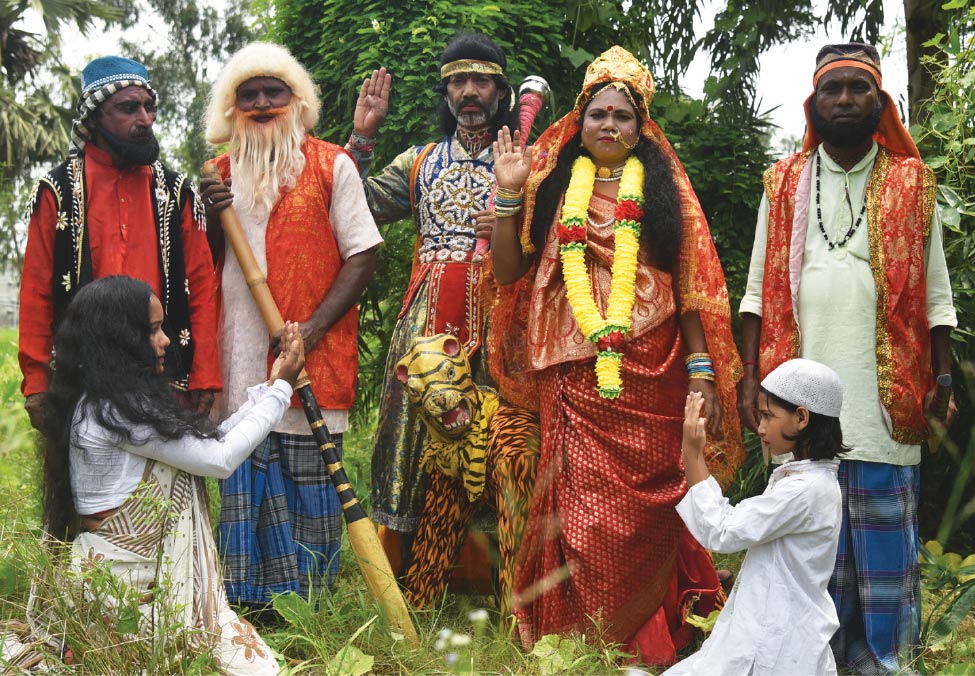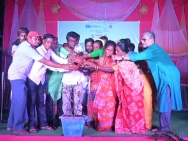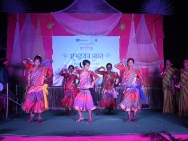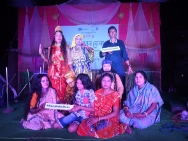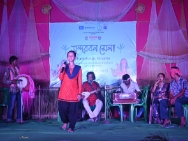Repertoire
Traditional Discription:
The local goddess, Banbibi, saves a child named Dukhe from tigers after he is offered as a sacrifice by Dhana, a trader from Bangladesh. The trader does this to appease Dakshin Rai, the god of the tigers so that he can collect honey from the forest without any hindrance. While the duration varies from three to four hours, the dialogues are in the local dialect, songs in the Bhatiyali folk form and the music is composed with dhol, tabla and cymbals as well as keyboards.Goddess Banbibi gained prominence as people venturing into the forests prayed to her to save them from tiger attacks.
Contemporary Discription:
There has been little change in Banbibir Pala over the years except the pronunciation of the artists. Also, unlike in the past when men used to play women characters, women themselves play the roles now. The duration has also shortened to 45-70 minutes, keeping the tourist audience in mind, and the language has changed from the local dialect to urban Bengali.
We have a expert Artists to serve you.
Top Artists
BANKURA
BIRBHUM
MURSHIDABAD
NADIA
BANKURA
BIRBHUM
MURSHIDABAD
NADIA
BANKURA
BIRBHUM
MURSHIDABAD
NADIA
BANKURA
BIRBHUM
MURSHIDABAD
NADIA
BANKURA
BIRBHUM
MURSHIDABAD
NADIA
BANKURA
BIRBHUM
MURSHIDABAD
NADIA
BANKURA
BIRBHUM
MURSHIDABAD
NADIA
BANKURA
BIRBHUM
MURSHIDABAD
NADIA
BANKURA
BIRBHUM
MURSHIDABAD
NADIA
BANKURA
BIRBHUM
MURSHIDABAD
NADIA
BANKURA
BIRBHUM
MURSHIDABAD
NADIA
BANKURA
BIRBHUM
MURSHIDABAD
NADIA
BANKURA
BIRBHUM
MURSHIDABAD
NADIA
BANKURA
BIRBHUM
MURSHIDABAD
NADIA
BANKURA
BIRBHUM
MURSHIDABAD
NADIA
BANKURA
BIRBHUM
MURSHIDABAD
NADIA
BANKURA
BIRBHUM
MURSHIDABAD
NADIA
Find Your Favorites Among Our Diverse Art
The Panchmura terracotta artisans have deep-rooted traditions
Panchmura in Taldangra Block is a prominent hub of terracotta artists.
BANKURA
Bankura has a rich cultural and traditional heritage and is known for its traditional music, craft!!
NADIA
Nadia district with Bhagirathi River on the West and Mathabhanga in the North is best remembered f!!
MURSHIDABAD
Murshidabad is a district of West Bengal with its district headquarters in Baharampur town. There !!
BIRBHUM
Birbhum district often called the ‘land of red soil’, is noted for its landscape and cultural heri!!
No publication data found!
Village Festival
Sundarban Mela was held at Pakhiralay, Gosaba on Apr 15th and 16th from 5 pm to 8 pm to celebrate the Intangible Cultural Heritage (ICH) of Sundarbans. The festival was part of the collaborative initiative, Rural Craft and Cultural Hub (RCCH), undertaken by the Department of MSME&T, Govt. of West Bengal in association with UNESCO to strengthen ICH-based practices of the state and promote the grass-root creative entrepreneurs. On 15th April, Sundarban Mela started with a Baul music performance by Rahul Sardar and team from Nadia. The festival was inaugurated by Jhumur, Baul and Banabibi Pala artists from Sundarbans by watering a plant. Then the evening cultural program started with a Jhumur dance and music performance by Adibasi Banophul Sampraday (Led by Bablu Sardar), Shiv Durga Jhumur Sampraday (Shila Sardar) showcased their local culture and tradition through jhumur dance to the audience. Later, Adivasi Lokosanskriti (Bandana Sardar and team) group performed Jhumur dance accompanied with adivasi song. The last performance of the day was Banabibir Pala, the traditional folk theatre acted to please goddess Banabibi to protect the honey collectors from man eating tigers and keep their family and loved ones safe. The performance was enacted by Ma Suhashini Natya group from Sundarban led by Anuja Adhikari and her team. Sundarban being a tourist location and during the festival there were many outsiders to whom the performance was very touchy and they felt very happy to witness such a theatrical performance imbibed with the lifestyle of the people of Sundarbans. On 16th April, the festival started with Jhumur song and dance performance by Tusu Mata group and Pakhi Jhumur Sampraday (led by Putul Mandal) which was highly appreciated by the audience. As the tunes of Dotara started, the audience came live with and responded heartily to Bhatiyali music performance by Nabaneeta Mandal and team. Due to audience request the performance lasted an hour creating a different aura of music around the area. The last performance of Sundarban Mela was Chau dance from Purulia. It is a folk artform with elements of martial arts. Chau dance is performed with Chau masks and the dancers are highly skilled to perform vaults and jumps according to the beats of Dhamsa. The performance was led by Jagannath Choudhury and team Mitali Chau Maldi. They performed ‘Raaktasur Badh’ a performed of one hour which hold the audience to their chair. The performance was highly appreciated by the audiences and they proposed to have the team during others festivals in the area. Other than the main stage performance there were craft stall on the mela ground covering Shola, Stone jewellery, Incense, wood craft and hay craft.
International Visit
No folk artists visited abroad as of now.
A Folk Art Centre has been set up at Pakhiralay, Gosaba.
